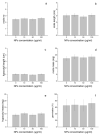Influence of GdVO4:Eu3+ Nanocrystals on Growth, Germination, Root Cell Viability and Oxidative Stress of Wheat (Triticum aestivum L.) Seedlings
- PMID: 34200921
- PMCID: PMC8230434
- DOI: 10.3390/plants10061187
Influence of GdVO4:Eu3+ Nanocrystals on Growth, Germination, Root Cell Viability and Oxidative Stress of Wheat (Triticum aestivum L.) Seedlings
Abstract
The increasing application of lanthanide-doped nanocrystals (LDNCs) entails the risk of a harmful impact on the natural environment. Therefore, in the presented study the influence of gadolinium orthovanadates doped with Eu3+ (GdVO4:Eu3) nanocrystals on wheat (Triticum aestivum L.), chosen as a model plant species, was investigated. The seeds were grown in Petri dishes filled with colloids of LDNCs at the concentrations of 0, 10, 50 and 100 µg/mL. The plants' growth endpoints (number of roots, roots length, roots mass, hypocotyl length and hypocotyl mass) and germination rate were not significantly changed after the exposure to GdVO4:Eu3+ nanocrystals at all used concentrations. The presence of LDNCs also had no effect on oxidative stress intensity, which was determined on the basis of the amount of lipid peroxidation product (thiobarbituric acid reactive substances; TBARS) in the roots. Similarly, TTC (tetrazolium chloride) assay did not show any differences in cells' viability. However, root cells of the treated seedlings contained less Evans Blue (EB) when compared to the control. The obtained results, on the one hand, suggest that GdVO4:Eu3+ nanocrystals are safe for plants in the tested concentrations, while on the other hand they indicate that LDNCs may interfere with the functioning of the root cell membrane.
Keywords: cell viability; lanthanide-doped nanoparticles; lipid peroxidation; nanotoxicology; phytotoxicity; vascular plants.
Conflict of interest statement
The authors declare no conflict of interest.
Figures




Similar articles
-
Influence of surface modification and size of lanthanide-doped upconverting nanoparticles on wheat seedlings.Chemosphere. 2024 Jan;347:140629. doi: 10.1016/j.chemosphere.2023.140629. Epub 2023 Nov 8. Chemosphere. 2024. PMID: 37949184
-
Determination of zinc oxide nanoparticles toxicity in root growth in wheat (Triticum aestivum L.) seedlings.Acta Biol Hung. 2016 Sep;67(3):286-96. doi: 10.1556/018.67.2016.3.6. Acta Biol Hung. 2016. PMID: 27630051
-
Phytotoxicity and oxidative effects of typical quaternary ammonium compounds on wheat (Triticum aestivum L.) seedlings.Environ Sci Pollut Res Int. 2019 Sep;26(25):25985-25999. doi: 10.1007/s11356-019-05822-7. Epub 2019 Jul 4. Environ Sci Pollut Res Int. 2019. PMID: 31273661
-
Wheat chronic exposure to TiO2-nanoparticles: Cyto- and genotoxic approach.Plant Physiol Biochem. 2017 Dec;121:89-98. doi: 10.1016/j.plaphy.2017.10.013. Epub 2017 Oct 19. Plant Physiol Biochem. 2017. PMID: 29096177
-
Toxic effect of perfluorooctanoic acid (PFOA) on germination and seedling growth of wheat (Triticum aestivum L.).Chemosphere. 2016 Sep;159:420-425. doi: 10.1016/j.chemosphere.2016.06.045. Epub 2016 Jun 20. Chemosphere. 2016. PMID: 27337433
Cited by
-
Toxicity Assessment and Control of Early Blight and Stem Rot of Solanum tuberosum L. by Mancozeb-Loaded Chitosan-Gum Acacia Nanocomposites.J Xenobiot. 2022 Apr 14;12(2):74-90. doi: 10.3390/jox12020008. J Xenobiot. 2022. PMID: 35466214 Free PMC article.
References
-
- Judy J.D., Bertsch P.M. Bioavailability, Toxicity, and Fate of Manufactured Nanomaterials in Terrestrial Ecosystems. Volume 123. Elsevier BV; Amsterdam, The Netherlands: 2014. pp. 1–64.
Grants and funding
LinkOut - more resources
Full Text Sources

